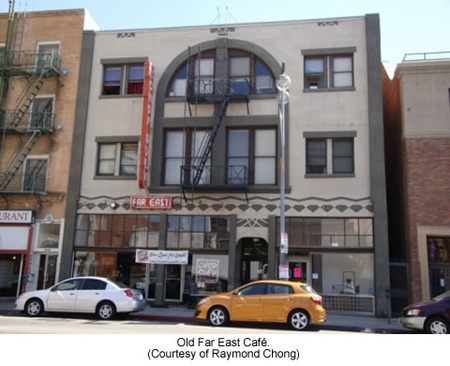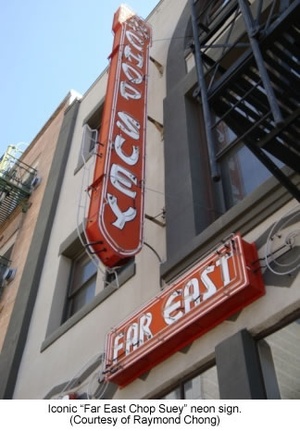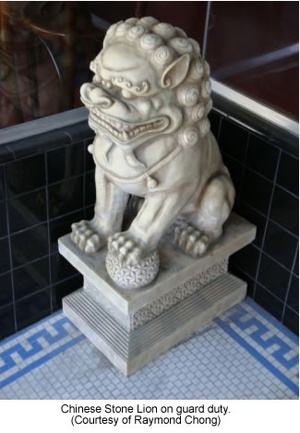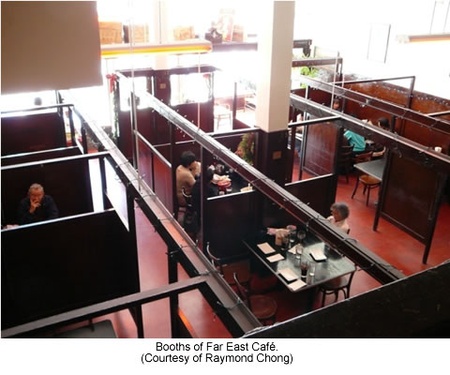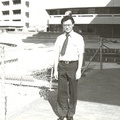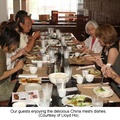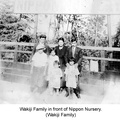Michael, my brother, and I hosted the “Far East Café Reunion – Memories and Nostalgia.” Our purpose was to celebrate the life of Gim Suey Chong and the legacy of famous Far East Café with relatives and new friends. On Saturday, June 7, 2008, we gathered at the mezzanine of the Chop Suey Café in the landmark Far East Café Building for the program and lunch, the room of countless parties, in two rows of tables.
During the program, we shared memorable and nostalgic stories. We feasted on the delicious China meshi (Cantonese) dishes. We first met as mysterious strangers but left the “Far East Café Reunion” as close friends. I was simply elated by this extraordinary party in Little Tokyo.
Gim Suey Chong, my father, was a proud weekend waiter at the storied Far East Café on 347 East First Street in the Heart of Little Tokyo. Gim worked for the Jung cousins of Hoyping County from the Pearl River Delta of Kwangtung Province in China. He served the popular China meshi dishes to customers with a smile on his face from 1950 to 1974. He talked, joked, and played with his fellow waiters, busboys, and cooks. He was among his brothers in this close-knit fraternity. Gim won many arm wrestling matches during their breaks. The Far East Café and its people were a vital part of his short but vibrant life (years 1922 to 1979).
It was a beautiful sunny Saturday morning in the Southland when I arrived in Little Tokyo. I was excited as well as anxious about the Far East Café reunion. I retraced the footsteps of Gim Suey Chong along East First Street in the historic Little Tokyo district. The iconic “Far East Chop Suey” neon sign on the façade proudly proclaimed this Chop Suey eatery to the world. In front, two stone Chinese lions stood protecting the Far East Café from evil spirits. “En To Low” (Far East Building in Chinese) was etched on the front glass door since 1935. I looked at the adjacent landmark Antonin Sperl Building. Then at the old Yet Quong Low (Sun Light Building in Chinese) Chop Suey Café (aka Nikko Low), Gim Suey Chong and Moi Chung, our grandfather, lived there and worked for Quock Den Jung and Hoie Wing Jung.
Omoide No Shotokyo (Remembering Old Little Tokyo) is sidewalk public art that honors Japanese Americans, their history and neighborhood. Etched into the sidewalk concrete in front of the building was "Far East Café (1935)." A reminder of how Little Tokyo used to be. Another memory in the sidewalk were the words of Little Tokyo resident, Penny Akemi Sakoda that reads: "My memory of hotel living are vividly etched in my mind. I hear the familiar sounds of the shamisen koto, and shigin being sung, and the constant clanking of the street car." Toyo Miyatake’s camera sculpture is nearby.
My imagination wandered to the days of Gim Suey Chong at the Far East Café. It is lunchtime on Saturday. Patrons were sharing quiet conversations in the booths. Upstairs in the mezzanine, a family was joyfully celebrating a birthday of a loved one with drinks and food. The cooks were in their usual frenetic pace in the kitchen as they created their succulent dishes in the fiery woks. A strong aroma of the tasty foods waffled in the air. Gim Suey Chong and fellow waiters were smoothly serving the China meshi dishes. From the front counter, Look Mar admired the scene of the good times among his guests at the venerable Far East Café.
At 11 a.m., I walked into the old Far East Café, now known as Chop Suey Café. Dark red booths on the red concrete floor, stood ready for the patrons. Fluorescent lights hung from the ceiling to cast an ambient dark red hue over the dining room. Black formica tables with soy sauce jars and round wood chairs. The lacquer wood panels were lined with advertising posters of Chinese girls of the 1930’s hawking cigarettes and other goods. Near the entrance, you can see the glass front counter where Look Mar greeted patrons, handled transactions at the cash register, and dispensed sweets to the kids. On the wall, two photos showed Look Mar, Do Mar, Mayor Thomas Bradley, and various workers.
Michael put together a beautiful program for the party. It included: the creative “China Meshi Dreams” by Tony Osumi, the legacy of Far East Café, and the life story of Gim Suey Chong, our father. Near the reception table, Michael put up a poster of the Far East Café. It included “Valley Girl's Memories of the Far East Café” by Jennie Kuida, “A Dark Show Fell on My Chop Suey” by Naomi Hirahara, “Far East Café Groundbreaking Ceremony" by Wataru Ebihara, "The China Meshi Manifesto" by Tony Osumi, and “Far East Building – A Salute to Preservation” by Restore America.
At noon, I happily began our program. I warmly welcome our guests for this unique occasion of memories and nostalgia for the Far East Café. I gave them a brief description for today’s China meshi menu for lunch. I talked about the importance of chop suey in American cuisine. The Issei and Nissei community enjoyed the delicious China meshi dishes of that era in America.
Tony Osumi, an aficionado of the Far East Café, had written a nice poem entitled “China Meshi Dreams,” an ode to the classic China meshi dishes.
China Meshi Dreams
relaxing in a hot tub of seaweed soup
nori and egg whites swirl
pork shoulder bobbing
translucent broth
cover my shoulders
lowering my chin to take a sipchashu
roasted brick red
chunks hang plump
like apples on a chashu tree
seedless
warm and ripe
there for the picking
licking fingers
shamelessly
not even my ownhomyu
pungent and fresh
melting in my mouth
with hot mustard and shoyu
whipped into circles
golden as Van Gogh’s Starry Night
new research finds:
homyu
fat free
sodium free
and lowers your
cholesterolshrimp and lobster sauce
ladled thick on steaming rice
a priceless
chawan treasure
overflowing with
orange rubies
black bean pearls
and egg white satin
magically
the last shrimp
reappearing after every bitechicken chowmein
pan fried timelines
thread through
shiitake and china pea
weave and tie us
to our pioneer past
every glazed noodle
guaranteed to have
an issei on the other endpakai
bell pepper and onion
witness the marriage
of pineapple and pork
with vinegar presiding
honeymooning
for seven days
and six nights
on a romantic
lazy susanalmond duck
cradled by lettuce
spruced up with nuts
born from hard times
scraps of duck meat
pressed between
heaven and earth
working peoples’
salvation--with gravy
my father says,
Almond Duck?
as hard to describe
as the grand canyon’s
beauty
I eagerly told the story of the old Far East Café in Little Tokyo. In 1935, five Jung cousins, from Le Chung Laundry in Mason City, Iowa, opened this establishment during the heyday of Little Tokyo. Anna May Wong, the famous actress, attended their grand opening. Far East Café was a popular gathering place for good Chinese food. Countless parties were held in the mezzanine. Issei and Nisei enjoyed the China meshi dishes among families and friends. They have strong sentiments for the Far East Café.
George Wakiji vividly described the fine dining of the old Far East Café:
In my younger days (pre-World War II) when I lived in Pasadena, California, it was always a treat to go to Little Tokyo in Los Angeles to eat China meshi, the popular Cantonese cuisine, at the Far East Café. I can still vividly recall the dark cherry wood panels, which covered the walls and booths. Sometimes when we had a family gathering on Sunday, I recall eating in a secluded mezzanine section in the back of the restaurant. Hanhichi Wakiji, my father, held court there. We never failed to order the same dishes each time. There was always pak kai (sweet and sour pork), pea chow yuk (Chinese pea and pork), chow mein (with chicken and pan-fried noodles), and wor shu op (almond duck). My favorite was cha shu (roast pork). In the ensuing years, I have eaten in many Chinese restaurants around the world, but have never found cha shu that matched the Far East Café version.
James Hajime Wakiji, my older brother, always had to have an order of hom yuk (pork hash with salted fish). After our return from incarceration from the Gila River Relocation Camp in the Arizona desert during World War II, I with my good friends played in the post-World War II Nisei Athletic Union (NAU) softball and basketball leagues in the greater Los Angeles area. After the games on Friday evenings, we invariably stopped in Little Tokyo and headed for the Far East Café. We gorged ourselves on the best Cantonese cuisine. In those days, they served the steamed rice in large rice bowls, which were mounded high. I remember that in addition to all the Chinese dishes I would down at least four of those bowls. Nowadays I would eat an eighth of that amount of rice. The Far East Café experience during my youth and adulthood are memories. Nevertheless, I will always remember and cherish it.
* If you want to share your stories and photos about the Far East Café, please contact Raymond Chong at 510.915.9810 (mobile) or raychong(at)prodigy.net (e-mail).
© 2008 Raymond Chong



